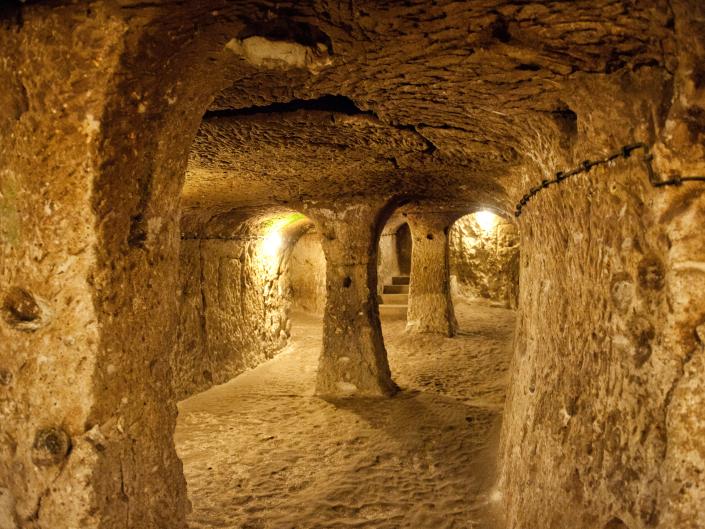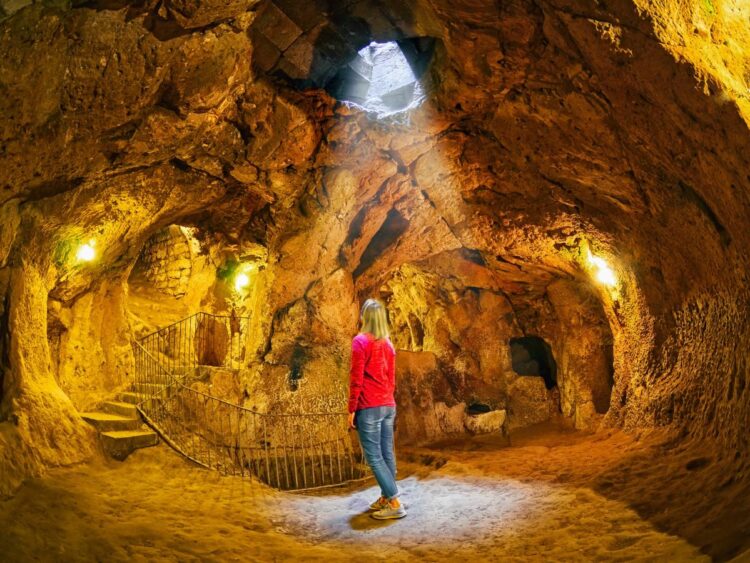
-
Derinkuyu is a subterranean city in Turkey stretching 280 feet below the Earth’s surface.
-
The ancient city was used for centuries before it was abandoned in the 1920s.
-
A local man rediscovered it in 1963 when he went looking for his lost chickens behind a wall.
Stretching 280 feet below the Earth’s surface in Cappadocia, Turkey, is a web of tunnels and cave-like dwellings that once housed 20,000 people.
The ancient city, Derinkuyu, lay abandoned for decades until, in the 1960s, a local man noticed his chickens were disappearing through a gap in his basement that had opened up during renovations, the BBC reported. After knocking down a wall, he found a tunnel — and accidentally rediscovered the sprawling, subterranean city.
Now part of a UNESCO World Heritage site, Derinkuyu is open to visitors, although they can only explore eight of its 18 levels. Here’s a closer look at the remarkable city and its history.
Derinkuyu is an 18-level underground city in the Cappadocia region of Turkey. At its deepest point, it reaches 280 feet below the Earth’s surface.

Source: BBC
Cappadocia is particularly suited to underground dwellings — its landscape is made of a volcanic-ash rock called tuff, which is pliable and dry, making it easy to carve with simple tools.

In 1963, a local man was remodeling his home and noticed his chickens were disappearing through a gap that had opened up. After he pulled back a wall, he found a tunnel that led to Derinkuyu.

Source: BBC
More than 600 entrances to the ancient city have since been found within people’s homes, the BBC reported.

Source: BBC
According to Turkey’s Department of Culture, it was built by the Phrygians in the 8th to 7th centuries BC. It was first referenced in a written text in 370 BC.

Source: Cappadocia Turkey, BBC
It was used for thousands of years — at first for storage, and then as a place for people to hide from invasions and conflict.

Source: BBC
Its dwellers were able to survive underground for months at a time. At its peak, it was home to 20,000 people.

Source: CNN
However, in the 1920s, it was abandoned by the Cappadocian Greeks when they fled to Greece during the Greco-Turkish War.

Source: BBC
After the city was rediscovered in the 1960s, excavators found rooms for many different purposes, including food storage, winemaking, oil pressing, and dining.

Source: Cappadocia Turkey
They also unearthed a chapel, pictured, and a religious school.

Source: Cappadocia Turkey
When the city was inhabited, livestock was kept on floors nearer the surface so their smells and gasses did not affect lower dwellings.

Source: BBC
A well provided clean water, and ventilation shafts allowed fresh air to circulate between the rooms and levels.

Source: BBC
There were also large, stone doors on every floor to stop intruders.

Source: Cappadocia Turkey,
A guide told BBC reporter Geena Truman that “life underground was probably very difficult. The residents relieved themselves in sealed clay jars, lived by torchlight, and disposed of dead bodies in [designated] areas.”

Source: BBC
In 1985, the region was added to the UNESCO World Heritage list.

Source: UNESCO
Today, Derinkuyu, which is now the largest excavated underground city in Turkey, is open to visitors.

Read the original article on Insider
[ad_2]
Source link







